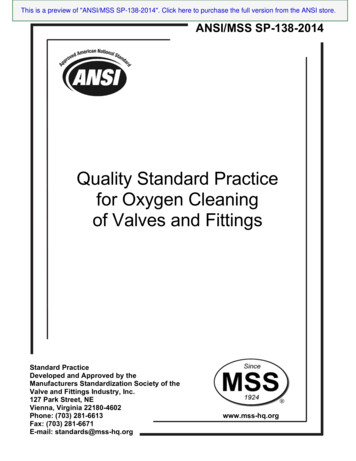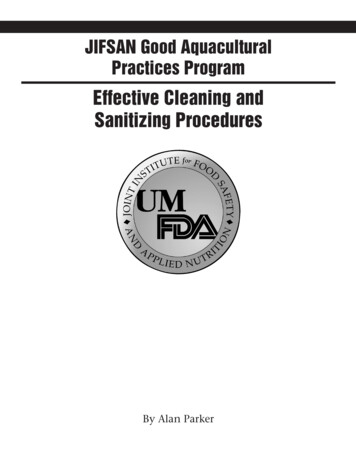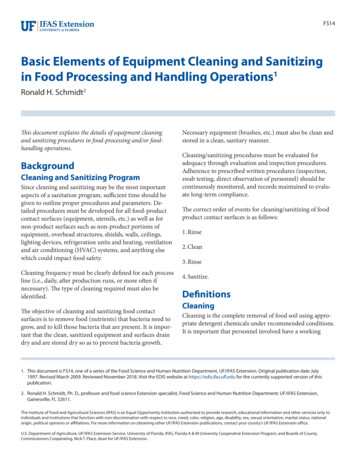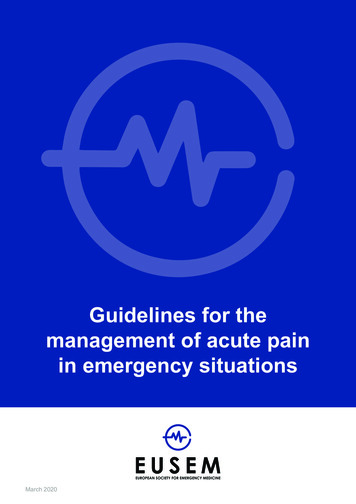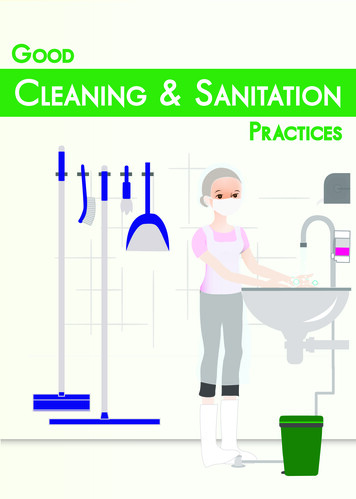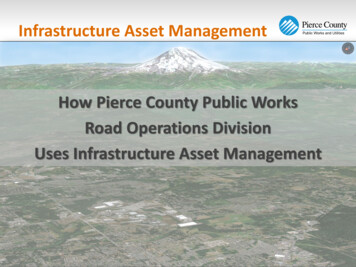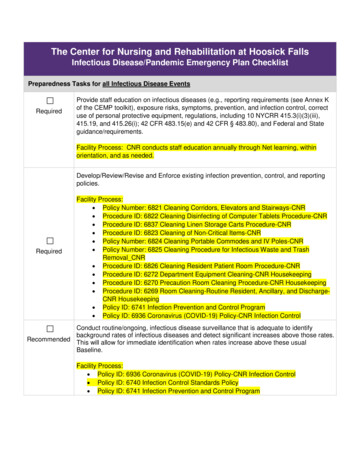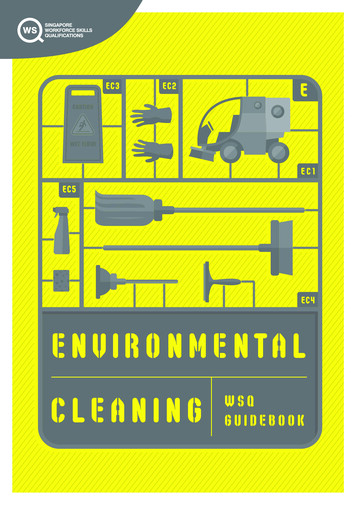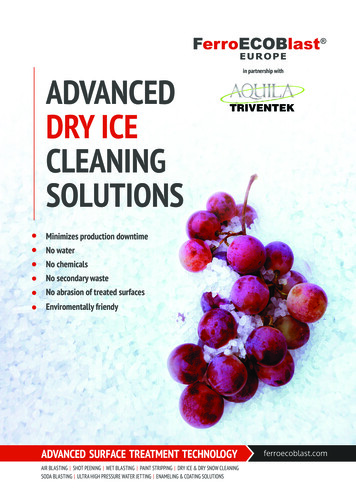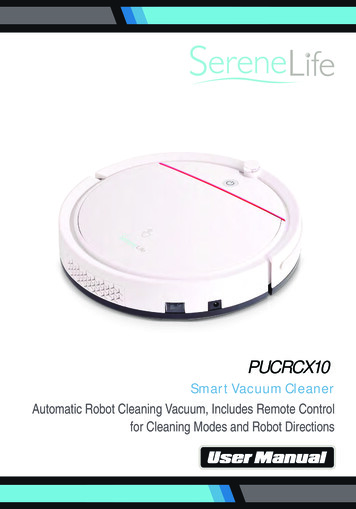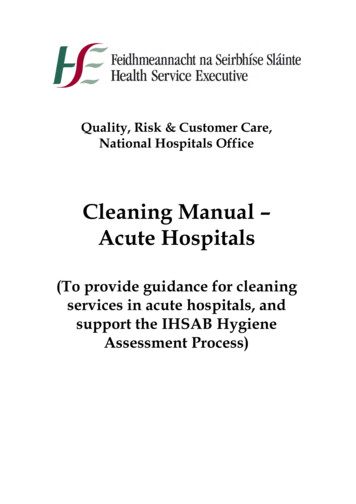
Transcription
Quality, Risk & Customer Care,National Hospitals OfficeCleaning Manual –Acute Hospitals(To provide guidance for cleaningservices in acute hospitals, andsupport the IHSAB HygieneAssessment Process)
National Hospitals Office – Cleaning Manual for Acute HospitalsAcknowledgementThis manual has been developed by the National Hospitals Office as part ofits remit under quality, risk and customer care. The manual is as a result ofthe many submissions arising from the consultation process undertaken indeveloping hygiene services standards. The Quality, Risk & Customer CareDepartment in the National Hospitals Office would like to extend thanks toall staff who made submissions, Network Managers, Hospital CEOs andManagers, Partnership Facilitators and the National Working Groupmembers for their ongoing cooperation and commitment as we strive forstandards of excellence in hygiene.Note: This Manual should be used in association with and in accordance with localpolicy.2
National Hospitals Office – Cleaning Manual for Acute HospitalsContents1. Cover2. Acknowledgement3. Contents6. Foreword8. Summary9. Remit & Membership10. Development of National Hygiene Standards11. Partnership with the Irish Health Services Accreditation Board13. The Irish Healthcare Acute Hospitals Cleaning Manual – Introduction17. Section 1 – The Cleaning Function, 1.1 Introduction, What is Cleaning ?18. 1.2 Cleaning Element Standards19. 1.3 Hospital Cleaning – a priority issue20. 1.4 Empowering Patients, 1.5 Infection Prevention & Control1.6 Staff Education & Training, 1.7 Infrastructural & Maintenance Aspects1.8 Associated Departmental Responsibilities21. 1.9 Cleaning During Construction Works22. 1.10 Measurement & Auditing23. 1.11 National Risk Categories, 1.12 National Minimum Cleaning Frequencies25. 1.13 Auditing Procedures (technical, managerial and external audits)26. Figure 1 - Audit Frequency Table27. 1.14 The Cleaning Audit Tool(see appendix 2 & Excel document accompanying)28. Figure 2 – Time Frame for Corrective Action29. A Ward Cleaning Management System33. Section 2 – Infection Prevention & Control, 2.1 Best Practice Measures,2.2 Introduction34. 2.3 Definitions35. 2.4 Classification of Infection Risk / Risk Assessment36. 2.5 Infection Prevention & Control Measures, a) Colour Coding,b) Protective Gloves37. c) Disposable Plastic Aprons, d) Safety Goggles and Masks / Visors38. Figure 3 – General Guidance P.P.E.39. e) Accidental Exposure, f) Safe Disposal of Sharps, g) Spillages40. Management of Blood and Other Body Fluid Spillages Policy and Procedure42. h) Waste Disposal, i) Segregation of Linen43. j) Decontamination of Patient Equipment, Single Use Items Symbol44. k) Hand Hygiene and Skin Care, l) Jewellery46. Section 3 – The Management of Patient Equipment, 3.1 Introduction, 3.2 Why ?47. 3.3 Responsibilities, 3.4 Cleaning of Patient Equipment,3.5 Preparation and P.P.E.3.6 Cleaning Patient Equipment48. 3.7 Summary of Methods for Decontamination of Patient Equipment49. Choosing the Method, 3.8 Decontamination of Healthcare Equipment50. Decontamination of Equipment Prior to Service or Repair52. Section 4 – Health & Safety, 4.1 Legislation, Safety, Health and Welfare 200553. Protective Equipment, Reporting of Accidents, 4.2 Health & Safety Guide54. b) General Rules, c) Protective Clothing, d) Jewellery55. e) Accidents, f) Personal Hygiene, g) Food Hygiene, h) Kitchen Hygiene56. 4.3 Safe Manual Handling, 4.4 Cleaning EquipmentNote: This Manual should be used in association with and in accordance with localpolicy.3
National Hospitals Office – Cleaning Manual for Acute Hospitals59. Section 5 – Cleaning Method Statements, 5.1 Introduction,5.2 Best Practice Notes61. Task 1 – Dust Controlling62. Task 2 – Mopping (Damp / Flat / Spot)63. Task 3 – Spray Cleaning / Buffing / Burnishing65. Task 4 – Floor Scrubbing67. Task 5 – Floor Stripping69. Task 6 – Applying Floor Polish71. Task 7 – Floor Sealing73. Task 8 – Stain Removal75. Task 9 – Vacuum Cleaning76. Task 10 – Water Extraction77. Task 11 – Carpet Shampoo79. Task 12 – Damp Dusting80. Task 13 – Radiator Cleaning81. Task 14 – Bed / Patient Trolley82. Task 15 – Glass Cleaning83. Task 16 - External Glass Cleaning84. Task 17 – High Dusting85. Task 18 – Furniture Polishing86. Task 19 – Wall Washing88. Task 20 – Kitchen Cleaning – Ice Making Machine89. Task 21 – Kitchen Cleaning – Mechanical Waste Disposal Unit (gobbler)90. Task 22 – Kitchen Cleaning – Microwave91. Task 23 – Kitchen Cleaning – Refrigerator92. Task 24 – Kitchen Cleaning – Sink93. Task 25 – Washroom Cleaning – Bath94. Task 26 – Washroom Cleaning – Wash Hand Basin96. Task 27 – Washroom Cleaning – Replenishing Soap Dispensers97. Task 28 – Washroom Cleaning – Replenishing Paper Towel98. Task 29 – Washroom Cleaning – Replenishing Toilet Roll / Tissue99. Task 30 – Washroom Cleaning – Shower101. Task 31 – Sanitary Cleaning – Sluice102. Task 32 – Sanitary Cleaning – Toilet104. Task 33 - Sanitary Cleaning – Urinal105. Task 34 – Specialist Cleaning – Curtain Changing106. Task 35 – Specialist Cleaning – Steam Cleaning108. Microfibre Cleaning System – Method Statement111. Section 6 – Guidance on Contracting for Cleaning Services6.1 National Cleaning Specifications & Guide to Measuring Cleanliness112. 6.2 Selecting Best Value for Cleaning Contracts114. 6.3 Selecting Best Value – why it matters !115. 6.4 Criteria for Award of Tender116. 6.5 Final Selection of the Company118. 6.6 Defining Best Value in Cleaning Contracts, Cleaning Personnel121. Quality Criteria Relating to Cleaning Personnel,Contract Management / Operations122. Availability and Response Time, Operational Planning123. Support Services, Quality Assurance124. Inspections125. Quality Criteria Relating to Contract Management and Operations126. Contract Infrastructure, Equipment, Products, Quality CriteriaNote: This Manual should be used in association with and in accordance with localpolicy.4
National Hospitals Office – Cleaning Manual for Acute Hospitals127. Evaluation Guidelines128. The Importance of Selecting Companies Able to Provide a Quality Service129. Contract Award Process132. Determining the ‘Best Value’ Provider134. Selection Criteria (SAMPLE)135. Award Criteria (SAMPLE)139. Cleaning Personnel Criteria (SAMPLE)141. Contract Management / Operations Criteria (SAMPLE)142. Contract Infrastructure Criteria (SAMPLE)144. Section 7 – References and Submissions ListingNote: This Manual should be used in association with and in accordance with localpolicy.5
National Hospitals Office – Cleaning Manual for Acute HospitalsForewordIn February 2005 the National Hospitals Office (NHO), established a workinggroup to evaluate the current status of infection control and cleaning servicesin acute hospitals. The group identified a need to develop uniform standards,guidelines and audit processes across Irish acute hospitals, and in response tothis need, the working group as established under the auspices of the NHO,developed draft hygiene services standards for acute hospitals.In July and August 2005, the standards were developed by drawing on andevaluating existing infection prevention and control and cleaning standards inboth the national and international health sector.The draft Hygiene Standards were developed as follows:· An extensive literature search· A review of available literature and best practice· Synthesis of findings into a set of draft standards· Consultation with key stakeholdersIn order to ensure the workability of the standards a national consultationprocess was undertaken on a network by network basis with both clinical andnon-clinical staff involved. This consultation process served to reshape thedraft standards and established the need for a national assessment process.In autumn 2005 the Irish Health Services Accreditation Board (IHSAB),following a request from the Department of Health and Children to work withthe Health Service Executive (HSE) in developing the standards and a nationalassessment process, met with the NHO to discuss the process. To this end thedraft standards were realigned using feedback from the consultation processalready undertaken by the NHO. Further realignment used feedback from thepilot process, from within the NHO, the NHO national working group, twospecific working groups within hospitals and a consultation forum with keyrepresentatives.The IHSAB Hygiene Services Standards incorporate the following areas:Environment, Waste Management, Ward Kitchens, Linen, Sharps, HandHygiene and the Management of Patient Equipment, and aims to provide staff,visitors and patients with a common understanding when they ask thequestion “What is the standard of hygiene in this hospital?”This cleaning manual aims to provide national guidance specifically in the areaof the Environment, or environmental cleanliness.Note: This Manual should be used in association with and in accordance with localpolicy.6
National Hospitals Office – Cleaning Manual for Acute HospitalsTo date there has been no national guidance or instruction for hospitals interms of managing their environment and this was a common theme expressedby staff throughout the consultation process.The clarity of cleaning standards is of paramount importance. Hospital staffand cleaning contractors need to have the same understanding of the cleaningstandard and required tasks to ensure that they are working towards, andassessing, the same cleaning outcomes.The recommendations of both national hygiene audits highlighted the need fora range of processes and documentation to be in place in hospitals to aid themin attaining standards, and enhance the potential for them to be consistentlyclean.This cleaning manual therefore, provides advice and guidance concerning thegeneral cleaning of the hospital environment including all fixtures, fittings andequipment and contains an overview in relation to infection prevention andcontrol issues and the cleaning of patient equipment.This manual has been designed to support the IHSAB Hygiene ServicesStandards, and complement existing national policies and procedures. It is notintended to replace key policies relating to cleaning. It is important that wherethe cleaning manual is adopted that it is clear which policy, procedure orprotocol in the hospital should be followed.Due to the complexities in cleaning services in our acute hospitals it isimportant to note that this national guidance aims to support a continuousimprovement process in all hospitals irrespective of their service type. Anumber of national policies and guidelines have also been included in themanual, individual hospitals can amend or adapt these for their own use.This guidance document is for use by staff with responsibility for cleaningservices as a resource to assist them in day to day operations as well as intraining and in attaining the hygiene services standards to promote highquality, consistent, service levels.Note: This Manual should be used in association with and in accordance with localpolicy.7
National Hospitals Office – Cleaning Manual for Acute HospitalsSummaryThe IHSAB Hygiene Services Standards cover the areas as audited as part ofthe national hygiene audits, i.e. Environment, Waste Management, WardKitchens, Linen, Sharps, Hand Hygiene and the Management of PatientEquipment.This cleaning manual has been designed to complement the IHSAB HygieneServices Standards, and provide support and guidance for staff in attaininghigh standards of environmental cleanliness.Staff throughout the consultation process engaged in for the development ofthe national hygiene services standards highlighted the lack of nationalguidance and support in this area.It is readily acknowledged that many hospitals have developed their ownpolicies and guidelines and it is intended that this national guidance willinfluence hospitals who have not as yet developed their own policies andguidance as well as lead to a standardised approach towards improvinghygiene services, with the end result being standards of excellence in hygienefor our patients, our staff and our visitors.This cleaning manual therefore serves as a reference guide to assist staff withresponsibility for, or involvement in, cleaning services in our acute hospitals.It further serves as a training aid, and as a resource in attaining the hygieneservices standards.This cleaning manual is reflective of the both the first and the second nationalhygiene audit report recommendations, and reflects requests from staffinvolved in cleaning services in our acute hospitals for national support andguidance in this area.Note: This Manual should be used in association with and in accordance with localpolicy.8
National Hospitals Office – Cleaning Manual for Acute HospitalsRemit and MembershipThe National Hospitals Office made hospital hygiene a priority from its inception.As a starting point a working group was established under the auspices of theNational Hospitals Office to establish the present state of infection control andcleaning services in publicly funded acute care facilities, and on discovering that therewere no national standards in this area heretofore, to develop a set of hygiene servicesstandards.Membership of the working group is representative of all staff with a keen interest in,or responsibility for hygiene. This project is an NHO initiative under the remit ofQuality, Risk and Customer Care in the National Hospitals Office. The NationalHospitals Office is committed to supporting staff as they strive for standards ofexcellence in Hygiene.Membership of the Working GroupNameTitleRichard BrutonRegional MaterialsManagerMarena BurdInfection Control NurseBreda CorriganInfection Control NurseDr Rob CunneyConsultant MicrobiologistMary Dockery(Feb-June 2005)Larry DunneMarie ListonDr Sheila McEvilly(Feb-June 2005)Mary MulliganDr Olive MurphyLorcan O’BrienDr Maire O’ConnorJuly 2005Grace Rothwell (Chair &Project Leader, June 2005)Winifred Ryan (Chair &Project Leader, Feb-June2005)Joan Somers-MeaneyJuly 2005Independent CleaningConsultantHousehold ServicesSupport Services Training& Development OfficerMedical Coordinator ofServices for Older PeopleHousehold ServicesConsultant MicrobiologistDeputy Chairman, EHOASpecialist in Public HealthMedicineNHO DirectorateOrganisationHSE North East AreaHSE Midland AreaMater Hospital, DublinHealth ProtectionSurveillance CentreDublinHSE Midland AreaHSE NW AreaHSE East Coast AreaMater Hospital, DublinBon Secours Hospital,CorkHSE Mid-Western AreaHSE Eastern RegionHealth Service ExecutiveNHO DirectorateHealth Service ExecutiveIrish Assoc. of Directors ofNursing & MidwiferyHSE MW AreaNote: This Manual should be used in association with and in accordance with localpolicy.9
National Hospitals Office – Cleaning Manual for Acute HospitalsDevelopment of Hygiene ServicesStandardsThe development of standards undertaken by the Working Group included:· An extensive literature search; review of available literature andbest practice;· Synthesis of review findings into a set of draft standards for use inacute facilities;· Preparation of a consultation paper setting out detailed proposals forhygiene standards for acute care facilities;· Invitation for comments from all interested parties; consultationperiod during which workshops were organised with groups of keystakeholders;· The views which emerged from this consultation process and fromthe national hygiene audit assisted in revising and developing anagreed set of national hygiene services standards.A consultative document was circulated to all acute hospitals and relevantstakeholders and feedback was received accordingly.Organisations/Groups to whom the National Hygiene Services Standardswere sent for consultation:···············Irish Society of Clinical MicrobiologistsInfection Control Nurses AssociationInfectious Disease PhysiciansSARI National Committee membersHospital Programme Managers/CEOsRCPI Faculty of Public HealthRCPI Faculty of Occupational HealthAcademy of Medical Laboratory ScienceDepartment of Health and ChildrenCleaning Services Managers in acute hospitalsPrincipal Environmental Health OfficersHealth & Safety AuthorityInstitute of Occupational Safety and HealthCatering Managers Association of IrelandOther key stakeholdersA series of half-day workshops were held during July and August 2005 in eachhospital network with groups of key stakeholders. Over 800 HSE employeesattended the sessions and all grades of staff were represented at theworkshops.Note: This Manual should be used in association with and in accordance with localpolicy.10
National Hospitals Office – Cleaning Manual for Acute HospitalsThe workshops were facilitated by the National Partnership Facilitators, whoserole was to ensure that information was captured under each of the questionsabove on templates as supplied and to document burning issues from each ofthe plenary feedback sessions. Members of the national working groupconducted the sessions.The working group met in early September 2005 to evaluate all collatedfeedback, i.e. feedback received directly in respect of the draft standardsdocument and feedback collated from the workshops. Amendments to thestandards document were agreed.Partnership with Irish Health Services Accreditation Board (IHSAB)Following a request from the Department of Health and Children the draftstandards documents were forwarded to the Irish Health ServicesAccreditation Board (IHSAB) in draft format for realignment for assessmentpurposes.As part of the development process undertaken by the IHSAB pilot sites wereselected by the NHO as follows:· Roscommon County Hospital· The Adelaide, Meath & National Children's’ Hospital (AMNCH)Tallaght· Midland Regional Hospital, TullamorePiloting was carried out in December 2005 by the IHSAB on behalf of theNHO.Further Work in March 2006 involved the establishment of working groups intwo hospitals and a consultation process with key stakeholders. The final set ofstandards is reflective of the feedback from the pilots, from within the NHO,the NHO working group and the two hospital working groups.The Hygiene Services Standards and Assessment Process are expected to befinalised in Autumn 2006.IHSAB intend to roll out this mandatory assessment scheme by reviewing eachhospital once a year. The option of a review visit is available if significant areasof concern are identified which require further follow up and review prior tothe next scheduled assessment. The length of time to conduct an assessmentwill be a day and a half to two days depending on the size of the hospital.Note: This Manual should be used in association with and in accordance with localpolicy.11
National Hospitals Office – Cleaning Manual for Acute HospitalsThe scheme will involve four distinct phases for each hospital, self-assessmentlasting two to three months, peer review which is an unannounced visit by ateam of trained assessors/peers which will take place within two to threemonths of the self-assessment process, award granted or declined with a reportoutlining strengths and areas for improvement, approximately eight weeksafter the peer review, and continuous improvement.Note: This Manual should be used in association with and in accordance with localpolicy.12
National Hospitals Office – Cleaning Manual for Acute HospitalsThe Irish Healthcare Acute HospitalsCleaning Manual - IntroductionIntroductionThe IHSAB Hygiene Services Standards incorporates the aspects as audited aspart of the National Hygiene Audits, i.e. Environment, Waste Management,Ward Kitchens, Linen, Sharps, Hand Hygiene and the Management of PatientEquipment.This cleaning manual supports the implementation of the IHSAB HygieneServices Standards by providing guidance and support in the area ofenvironmental cleanliness, and in turn supports the implementation andmonitoring of cleaning standards and aims to provide a methodology toensure our healthcare facilities are clean.In light of concerns in relation to healthcare associated infection this manualtakes cognisance of infection prevention and control issues. It is intended tocommence the development of National Infection Prevention and Controlstandards later this year.Successful strategies to prevent and control healthcare associated infections inhealthcare facilities include the following:······Ensuring that the organisational and structural arrangements are inplace to enable the implementation of effective infection controlprogrammes – see Hygiene Services Standards, and National InfectionPrevention and Control Standards will further ensure theseorganisational and structural arrangementsPolicies and procedures for the management of the patientenvironment, management of patient equipment, waste managementand the handling and disposal of linen and sharps – see HygieneServices Standards and the Cleaning Manual for Acute HospitalsGuidelines on hand hygiene – see SARIInfection ControlSubcommittee, Guidelines for Hand Hygiene in Irish Health CareSettingsCleaning, disinfection and sterilisation procedures for equipment – seeNational Cleaning Manual and National Infection Prevention andControl Standards to be developed later this yearEnvironmental cleaning – see Hygiene Services Standards and theCleaning Manual for Acute HospitalsControl of antibiotic prescribing – the National Infection Prevention andControl Standards will provide guidance in this areaNote: This Manual should be used in association with and in accordance with localpolicy.13
National Hospitals Office – Cleaning Manual for Acute HospitalsThis manual provides guidance in the area of environmental cleaning. A cleanenvironment also has an important role to play in reducing healthcareassociated infection, and is important for efficient and effective healthcare.Historically there have been no national hygiene services standards in acutecare facilities. And, although some hospitals had set guidelines in these areasthey were not uniform and had no regulatory substance. This manual supportsthe implementation of the National Hygiene Services Standards.Whether provided in-house or by contracted staff the cleaning service is acrucial component of a hospitals quality system to ensure the safety and wellbeing of patients, staff and visitors alike.A clean hospital can make a difference to how patients feel about how theyhave been treated.In addition to advice and guidance concerning the general cleaning of thepremises and equipment, this manual also contains an overview in relation toinfection prevention and control issues.Many hospitals already have some form of cleaning manual although this isnot universal. This Cleaning Manual acts as a benchmark against which suchinstructive material can be compared, and also provides hospitals without amanual, with guidance and advice. Due to the complexities that exist incleaning services in our acute hospitals it is not possible to be overlyprescriptive, but it is deemed far more appropriate and useful to provideguidance which hospitals themselves can amend or adapt as appropriate.At a strategic level hospitals are encouraged to set out how cleaning services fitwith their wider strategic aims and objectives, to recognise the contributionthat “cleanliness” can make.In this way hospitals can ensure that their cleaning services departments areproperly focussed, efficiently resourced and that they consistently deliver highquality services that are well regarded by patients.Hospitals should also have documented arrangements in the form of aspecification or service level agreement for cleaning at ward and departmentlevel, and a subsequent order of work, tailored to each ward / department.Each service level agreement should detail the range of services to be providedindicating who is responsible, the times and frequencies at which cleaning willtake place and who is responsible for making judgements about the quality ofservices delivered.Note: This Manual should be used in association with and in accordance with localpolicy.14
National Hospitals Office – Cleaning Manual for Acute HospitalsAt an operational level hospitals should ensure that each staff member withresponsibility for cleaning has the right level of training, the appropriateequipment, knows what needs cleaning and how often and is properlysupervised to ensure that things are done correctly in accordance with thestandard as laid down. It should also be documented as to who hasresponsibility for cleaning for every item requiring cleaning in the hospital.Cleaning services staff members are one part of a wider team who haveresponsibility for cleanliness. Staff who carry out cleaning services are oftenmultidisciplinary, and are members of the overall team that has responsibilityfor cleanliness.The Network Manager / C.E.O. / Hospital Manager have strategicresponsibilities, the Environmental Services Manager has responsibilities attactical level and the Cleaning Services Manager and Ward / DepartmentalManager ensures that the plans as documented are translated into front-lineaction.This manual supports action at all levels of responsibility.If the hygiene services standards establish the standard of hygiene in a hospitalthen the manual provides the foundation to issues around “How to clean thehospital?”, and in turn meet the Environment standards.Whilst this manual is aimed more at staff with responsibility for cleaningservices it is worth noting that cleaning is everyone’s responsibility.The use of this Manual will help staff provide the following benefits for thehospital and its patients, staff and visitors because its focus is about how toensure that things are done properly, and consistently.···A clean, comfortable and safe environment for patients, clients,visitors, staff and members of the general public;Increased patient confidence in local healthcare facilities in relationto environmental hygiene and the organisational commitment toreduce the incidence of healthcare associated infection;The opportunity to improve cleanliness standardsThe context for the Irish Healthcare Acute Hospitals Cleaning ManualThis manual can be applied at a wide range of healthcare facilities and may beimplemented in its’ entirety or adapted at local level.Note: This Manual should be used in association with and in accordance with localpolicy.15
National Hospitals Office – Cleaning Manual for Acute HospitalsSection 1Note: This Manual should be used in association with and in accordance with localpolicy.16
National Hospitals Office – Cleaning Manual for Acute HospitalsSection 1 - The Cleaning Function1.1 IntroductionCleaning services are being performed and managed in many ways in ouracute hospitals. This manual aims to provide defined and measurableoutcomes for cleaning irrespective of where the responsibility lies, and toimprove the quality of service provision by ensuring that all cleaning relatedrisks are identified and managed appropriately on a consistent and long-termbasis.What is Cleaning ?Cleaning is the physical removal of foreign material, i.e. bloody and bodysubstances, rust, dust, dirt, debris, spillages etc. Cleaning physically removesrather than kills micro-organisms. It is achieved with water, detergents andmechanical action.Direct spread of micro-organisms from floors, walls, ceilings, fittings etc. is notlikely. Dry clean surfaces away from direct patient contact are of smallinfection risk. Gram negative bacteria can grow readily in wet and moist areas.Cleaning by normal housekeeping methods, i.e. water, detergents andmechanical action, is sufficient for general hospital cleaning, and is also aprerequisite for decontamination. If an item is not cleaned, ‘dirt’ can preventan item from being decontaminated, i.e. the ‘dirt’ prevents the action of thedisinfectant, making it ineffectiveDisinfectants are only necessary to decontaminate when potential infection issuspected and after spillage or organic matter, blood, pus etc.Equipment used for cleaning should not contribute to dispersal of dust ormicro-organisms. Scrubbing machine tanks can be contaminated and requiredaily emptying and decontamination. Vacuum cleaners should be fitted withfilters which will not cause an increase in bacterial air contamination. Dampdusting or wet cleaning will result in less bacterial air contamination. Waterused for cleaning should be changed frequently.Note: This Manual should be used in association with and in accordance with localpolicy.17
National Hospitals Office – Cleaning Manual for Acute Hospitals1.2 Cleaning Element StandardsExcellence in patient care is dependent on getting the basics right, making surethe food is good, making sure that patients are cared for and that thesurroundings are clean, tidy, comfortable and safe.The IHSAB Hygiene Services Standards specifies standards in the areas ofEnvironment, Waste Management, Ward Kitchens, Linen Sharps, HandHygiene and the Management of Patient Equipment.This manual supports the implementation of the hygiene services standards,specifically the environment standard, by providing support and guidance tostaff with responsibility for or involvement in cleaning services.All healthcare facilities need to be able to demonstrate that their wards anddepartments are clean and that an acceptable level of cleanliness is maintainedat all times. This is best achieved as a multidisciplinary approach betweenservice providers and service users.A clean environment is fundamental to excellence in patient care and needs tobe prescriptive in terms of outcomes. All items to be cleaned need to havedocumented cleaning arrangements with prescriptive outcomes, hence,cleaning element specifications (see Appendix 1). All elements to be cleaned inthe typical ward environment have been categorised into 55 elements.Cleaning element specifications represent the specific outcome to be achievedon completion of cleaning, e.g.24. Radiators·Radiators including all component partsshould be should be clean
Quality, Risk & Customer Care, National Hospitals Office Cleaning Manual - Acute Hospitals (To provide guidance for cleaning services in acute hospitals, and

